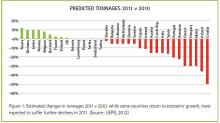A group of experts has looked at trends in the production and consumption of minerals in the UK over the past 40 years.
The headline findings show that overall, during the past 40-plus years the UK has become increasingly dependent on imports of minerals and minerals-based products, and this is likely to continue and increase as offshore oil and gas reserves run down.
Total UK minerals consumption (production + imports – exports) declined by about 35% between 1970 and 2011 from 619 million tonnes to 403 million tonnes and UK minerals production also declined by about 35%
At the same time the total value of UK minerals output increased in real terms by almost 300%, from £12.6 billion (€9.7 billion) in 1970 to £37.7 billion in 2011, largely due to offshore oil and gas production.
GB primary aggregates consumption (crushed rock, and sand and gravel) declined by nearly 30% between 1970 and 2011, from 208 million tonnes to 146 million tonnes after peaking at 300 million tonnes in 1989
Broadly over the same 1970-2011 period, production of GB brick clay fell nearly 78% from about 18 million tonnes to 4 million tonnes; GB cement raw materials fell 63% from 26.7 million tonnes (1974) to 9.9 million tonnes; Kaolin (china clay) , a major export mineral, fell by nearly 46% from 2.4 million tonnes to an estimated 1.3 million tonnes and ball clay, primarily for use in ceramics and also mainly exported, was one of the very few domestic minerals to have increased, by 27%, from 732,000 tonnes to 930,000 tonnes, peaking at nearly 1.1 million tonnes in 2000.
Potash mining, a potential growth sector, started in 1974 and reached an estimated 770,000 tonnes in 2011, peaking at 1.04 million tonnes in 2003.
Oil production increased from 156,000tonnes in 1970 to 44.6 million tonnes in 2012. It peaked at 137.7 million tonnes in 1999. Natural gas production increased from 9.7 million tonnes oil equivalent (oeq) in 1970 to 38.9 million tonnes in 2012. It peaked at 110.9 million tonnes oeq in 2000.
Salt production, important for the chemicals industry and road de-icing, fell by nearly 33% from 9 GB primary aggregates consumption (crushed rock, and sand and gravel) declined by nearly 30% between 1970 and 2011, from 208 million tonnes to 146 million tonnes after peaking at 300 million tonnes in 1989
This backward look has been produced to provide data in support of a study by a Working Group of the UK Minerals Forum on Future Minerals Scenarios for the UK.
The group is examining how the UK can maintain supplies of essential minerals over the next 35 years to 2050. What minerals will we need, where can they be found and will we be able to obtain them? It is looking particularly at minerals already being produced in the UK or which could be produced here.
The group’s findings will be reported to a CBI-sponsored Conference in London in November 2014.
Chairman of the UK Minerals Forum, Lester Hicks, said: “It has been well said – ‘if you can’t grow it, you have to mine it’. We cannot do without minerals, for energy, our homes, flood defence, chemicals and manufacturing. Many of our minerals, especially for construction, are still obtained in the UK. These would be especially hard and expensive to import. So where we get our minerals is important. But this interim report shows an overall pattern of declining domestic production and increasing imports over the past 40 years. It sets a challenging baseline from which future possibilities must be examined by the minerals industries, regulators, environmentalists and government”.








